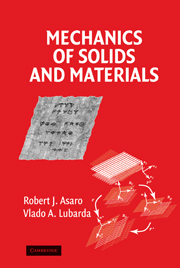Book contents
- Frontmatter
- Contents
- Preface
- PART 1 MATHEMATICAL PRELIMINARIES
- PART 2 CONTINUUM MECHANICS
- PART 3 LINEAR ELASTICITY
- PART 4 MICROMECHANICS
- 17 Dislocations and Cracks: Elementary Treatment
- 18 Dislocations in Anisotropic Media
- 19 Cracks in Anisotropic Media
- 20 The Inclusion Problem
- 21 Forces and Energy in Elastic Systems
- 22 Micropolar Elasticity
- PART 5 THIN FILMS AND INTERFACES
- PART 6 PLASTICITY AND VISCOPLASTICITY
- PART 7 BIOMECHANICS
- PART 8 SOLVED PROBLEMS
- Bibliography
- Index
22 - Micropolar Elasticity
Published online by Cambridge University Press: 06 July 2010
- Frontmatter
- Contents
- Preface
- PART 1 MATHEMATICAL PRELIMINARIES
- PART 2 CONTINUUM MECHANICS
- PART 3 LINEAR ELASTICITY
- PART 4 MICROMECHANICS
- 17 Dislocations and Cracks: Elementary Treatment
- 18 Dislocations in Anisotropic Media
- 19 Cracks in Anisotropic Media
- 20 The Inclusion Problem
- 21 Forces and Energy in Elastic Systems
- 22 Micropolar Elasticity
- PART 5 THIN FILMS AND INTERFACES
- PART 6 PLASTICITY AND VISCOPLASTICITY
- PART 7 BIOMECHANICS
- PART 8 SOLVED PROBLEMS
- Bibliography
- Index
Summary
Introduction
In a micropolar continuum the deformation is described by the displacement vector and an independent rotation vector. The rotation vector specifies the orientation of a triad of director vectors attached to each material particle. A particle (material element) can experience a microrotation without undergoing a macrodisplacement. An infinitesimal surface element transmits a force and a couple vector, which give rise to nonsymmetric stress and couple-stress tensors. The former is related to a nonsymmetric strain tensor and the latter to a nonsymmetric curvature tensor, defined as the gradient of the rotation vector. This type of the continuum mechanics was originally introduced by Voigt (1887) and the brothers Cosserat (1909). In a simplified micropolar theory, the so-called couple-stress theory, the rotation vector is not independent of the displacement vector, but related to it in the same way as in classical continuum mechanics.
The physical rationale for the extension of the classical to micropolar and couplestress theory was that the classical theory was not able to predict the size effect experimentally observed in problems which had a geometric length scale comparable to material's microstructural length, such as the grain size in a polycrystalline or granular aggregate. For example, the apparent strength of some materials with stress concentrators such as holes and notches is higher for smaller grain size; for a given volume fraction of dispersed hard particles, the strengthening of metals is greater for smaller particles; the bending and torsional strengths are higher for very thin beams and wires.
- Type
- Chapter
- Information
- Mechanics of Solids and Materials , pp. 375 - 406Publisher: Cambridge University PressPrint publication year: 2006



